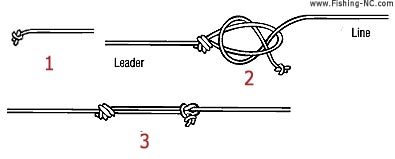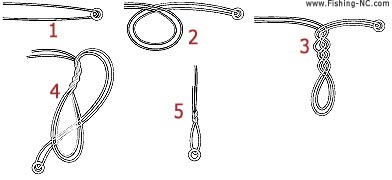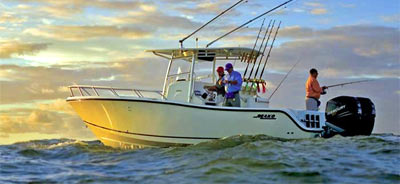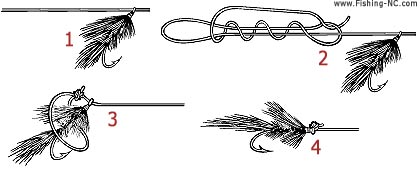Fishing Knots
The challenges fishing knots, of keeping line connected to a hook and joining two lines, are as old as fishing itself. Any fishing knot will create weakness in a line, but a correctly tied fishing knot will maintain far more line strength. The fishing knots below are each designed for a particular use and matching the knot to your needs and its application is just as important as trying it correctly. Learning a new know takes patience and practice. Some knots may seem as challenging as applying for a home mortage but with a simple cheat sheet you can tie fishing knots like a master. We highly recommend printing a few of these out and adding them to your tackle box - it's never as easy to remember that new knot technique when you are on the boat or in the surf fishing.
One thing to note, if you aren't using the Palomar fishing knot below, you need to start. The International Game Fish Association regards it as the strongest knot known for securing line to hooks, swivels, and artificial lures. It's very simple and will maintain more line strength than other fishing knots. We almost exclusively use Palomar knots when attaching any lure to fishing line, mono or fluorocarbon leaders, and even braid. One tip to improve the Palomar knot - wet the knot with some water or saliva before cinching it tight, this will improve knot strength.
Palomar Knot
Our overall favorite fishing knot for line and braid
The Palomar Knot is a general-purpose connection used in joining fishing line to swivels, snaps, hooks and artificial lures. The double wrap of through the eyelet provides a protective cushion for added knot strength. One of the strongest fishing knots, be sure to wet the line before cinching it tight.
- Double the line and form a loop three to four inches long. Pass the end of the loop through hook's eye.
- Hold standing line between thumb and finger, grasp loop with free hand and form a simple overhand knot.
- Pass hook through loop and draw line while guiding loop over top of eyelet.
- Pull tag end of line to tighten the knot snugly and trim the tag end to about 1/4 inch.

Albright Knot
The best fishing knot to connect line to leader when casting
The Albright Knot is most commonly used for joining monofilament or braided lines of unequal diameters, and for creating shock leaders. It is also used for connecting monofilament to wire.
- Bend a loop in the tag end of the heavier line and hold between thumb and forefinger of left hand. Insert the tag end of the lighter line through loop from the top.
- Slip tag end of lighter line under your left thumb and pinch it tightly against the heavier strands of the loop. Wrap the first turn of the lighter line over itself and continue wrapping toward the round end of loop. Take at least 12 turns with the lighter line around all three strands.
- Insert tag end of the lighter line through end of loop from the bottom. It must enter and leave the loop on same side.
- With the thumb and forefinger of left hand, slide the coils of lighter line towards end of loop, stop 1/8" from end of loop. Using pliers, pull tag end of lighter line tight to keep coils from slipping off loop.
- With your left hand still holding the heavier line pull on the standing part of the lighter line. Pull the tag end of the lighter line and the standing part a second time. Pull the standing part of the heavy mono and the standing part of the light line.
- Trim both tag ends.

Wedge Knot
An easier knot for leaders
The Wedge Knot is a general-purpose, easy to tie connection used in joining fishing line to a leader with a loop.
- Tie a knot in the end of fishing line.
- Pass the fishing line and knot through the leader loop and back around to form a simple knot.
- Pull both ends to cinch up tight.

Trilene® Knot
The fishing knot we use when a Palomar knot won't work
The Trilene Knot is a strong, reliable connection that resists slippage and premature failures. This fishing knot can be used in joining line to swivels, snaps, hooks and artificial lures. The knots' unique double wrap design and ease of tying consistently yields a strong, dependable connection.
- Run end of line through eye of hook or lure and double back through the eye a second time.
- Loop around standing part of line 5 or 6 times. Thread tag end back between the eye and the coils as shown.
- Tighten knot with a steady, even motion without hesitation. Trim tag end leaving about 1/4 inch.


Berkley® Braid Knot
This special fishing knot has been extensively tested by the Berkley R&D staff and has proven to be one of the best for use with the new braided lines.
- Run a double loop through the eye of hook or lure.
- Loop around the end of line and standing part of braided line 8 times. Thread double loop back between the eye and coils.
- Tighten knot with a steady, even motion without hesitation. Trim double loop and end of braided line leaving about 1/4 inch.

Arbor Knot
The Arbor Knot provides the angler with a quick, easy connection for attaching line and is excellent for trying fishing line to the reel spool.
- Pass the line around the reel arbor.
- Tie an overhand knot around the standing line. Then tie a second overhand knot in the tag end.
- Pull the line tight and snip off excess. Snug down the first overhand knot on the reel arbor.

Kingsling Knot
The King Sling Knot offers the angler an easy-to-tie end loop knot which is used primarily as a connection for crank baits and other artificial lures. This fishing knot allows the lure to work freely, making it more lifelike, and resulting in more strikes.
- Insert the tag end of the line through the artificial bait so that it extends eight to ten inches.
- Hold the tag end and the standing line in your left hand, and form a loop.
- With the bait in your right hand make four turns around the tag end and the standing line above the loop.
- Bring the bait down and through the loop.
- To tighten, hold the line above the loop length and pull the tag end and the standing line at the same time. Trim the tag end.

Nail Knot
The Nail Knot is generally used to attach fly line to fly line backing but this knot can also be used to attach leader to fishing line. The nail knot makes a strong smooth knot that rolls out when casting and is good for attaching two lines of different diameters.
- Hold nail or needle, tip of fly line and backing material between thumb and forefinger. Wrap backing 6 or 7 turns. Wind carefully for a tight, smooth knot. Stick end of backing between nail and fly line.
- Remove nail. Holding coils carefully between thumb and forefinger, alternately pull both end of backing with free hand to tighten.
- Snip off excess backing and end of fly line.


Interested in getting a boat loan for purchasing a new or used boat but conerned
about your credit score? The process of getting a bank to loan you money to buy a boat
can be tricky. Learn more in our guide to boat loan basics.
Snell Knot
The Snell Knot provides a strong connection when fishing with bait and using a separate length of leader. You can only use a snell knot with a leader.
- Insert one end of the leader through the hook's eye extending one to two inches past the eye. Insert the other end of the leader through the eye in the opposite direction point towards the barb of hook. Hold the hook and leader ends between thumb and forefinger of your left hand. Leader will hang below the hook in a large loop.
- Take the part of this loop that is closest to the eye and wrap it over the hook and shank and both ends of the leader toward the hook's barb. Wrap for 7 or 8 turns and hold wraps with left hand. Grip the end of leader that is through the eyelet with your right hand and pull it slowly and steadily. Hold the turns with your left hand or the knot will unravel.
- When the knot is almost tight, slide it u against the eye of the hook. Grip the short end lying along the shank of the hook with a pair of pliers. Pull this end and the standing line at the same time to completely tighten the knot. Trim the tag end.

Specialist Fly Knot
The Specialist Fly Knot is used to attach the fly to the leader.
- Place the leader through the fly eyelet and slide the fly up the leader out of the way before beginning knot.
- Make an oval loop and hold each end while wrapping the leader around the loop center 3 or 4 times.
- Stick end of leader through loop closest to fly and cinch knot snug.
- Trim tag end then place the fly though the loop and pull the knot snug.

Double Surgeon's Loop Knot
The Double Surgeon's Loop is a quick, easy way to tie a loop in the end of a leader. This fishing knot is often used as part of a leader system because it is relatively strong.
- Double the tag end of the line. Make a single overhand knot in the double line.
- Hold the tag end and standing part of the line in your left hand and bring the loop around and insert through the overhand knot.
- Hold loop in your right hand. Hold the tag end and standing line in your left hand.
- Moisten the knot in water and pull to tighten. Trim tag end to about 1/8 inch.

knot collection, please email us at info@fishing-nc.com. We are currently working to expand our knot collection to include more knots and instructional videos of knot tying techniques, any suggestions are sincerely appreciated.








